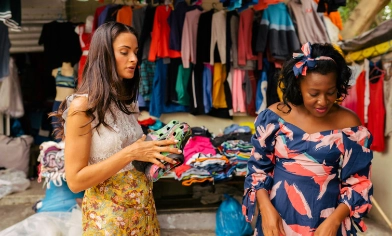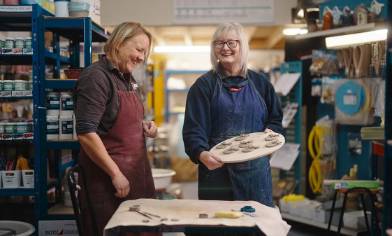Make, sell, repeat
Starting a small business for your homemade creations can be exciting and rewarding. As well as bringing in a few extra pounds, becoming a maker can boost your creativity and help you feel a real sense of accomplishment.
And the way you sell is up to you. Be it online or through local fairs and markets, there are plenty of ways for your handcrafted treasures to reach potential buyers.
Selling your creations online
Digital marketplaces have opened up a world of opportunities for artisans and creators to turn their hobbies into income. Selling online allows you to reach a global audience from the comfort of your own home. There are a lot of quick and easy ways to send your parcels around the world, and you can find a range of international postage services at your local Post Office branch.
Here are a few tips on how to get started:
1. Create your brand
Start by brainstorming a list of simple yet memorable brand names. Think about the story you want your brand to tell and what might resonate with your audience.
Once you’ve chosen a name, you can design a logo. Take advantage of free online graphic design tools like Canva or LogoMakr, which come with customisable templates and drag-and-drop features.
If you’re a more seasoned designer, you could use Photoshop or Illustrator to create your logo from scratch.
2. Set up a website or an online marketplace account
Next, it’s time to build your online presence. You can buy a domain name and create your website quickly and easily on platforms like Squarespace. If you want more flexibility, you can try WordPress, although navigating your way through its various features might require a little more effort.
To reach a wider audience, you can also set up an online marketplace account on platforms like eBay or Amazon Marketplace. That way, you can also offer services like Click & Collect, along with clear returns policies, which can be convenient for customers. Remember, customers often consider returns policies when deciding to buy, so make sure yours is clear from the get-go.
If you’re selling more personalised products, think about selling on Etsy and tap into an audience of craft enthusiasts, collectors and people looking for vintage or handmade items.
3. List your products
Lights, camera, action. It’s important to have high-quality photos of your items, so make sure your images are clear, well-lit and showcase your creations from multiple angles. You could also invest in a ring light or photo light box to lend you a helping hand.
Next, add detailed descriptions to your listings. Talk about the unique features of your products. Be as specific about dimensions, sizes and materials. And don’t forget to include relevant SEO keywords that potential buyers might use to find your items.
4. Set your prices
Pricing can be tricky but, if you get it right, you’ll attract buyers and make a profit. Have a look at what similar items are selling for and consider your costs, including materials, time, and the fees charged by the platform you’re selling on.
5. Spread the word on social media
Give your brand an extra boost by setting up business accounts on platforms like Facebook, Instagram and TikTok. Promote your products with engaging photos and videos. And engage with your followers by sharing behind-the-scenes content and even jumping on viral social media trends.
When it comes to writing captions, remember to use relevant keywords and hashtags to help more people find your content.






















